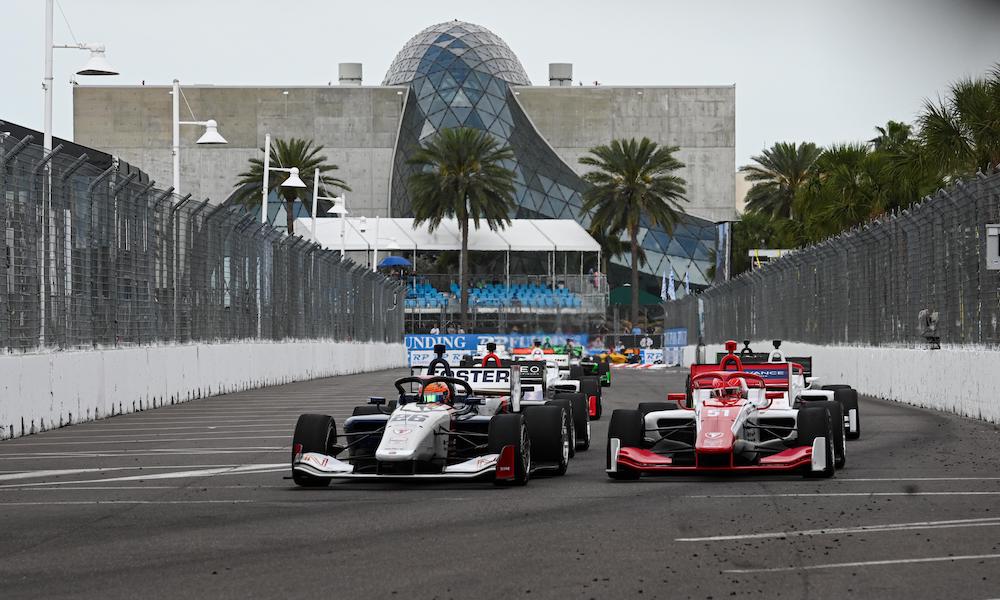The big news this year in American junior open-wheel racing is the growth of the Indy NXT by Firestone series.
In its expansion from 12 full-time cars in 2022 during the first year under Penske Entertainment’s control to the 19 full-time entries that took part in the season-opening race earlier this month in St. Petersburg, Indy NXT has been a great year-to-year success story that speaks to the efforts by its owner to grow the top training category. Those 19 entries are spread across six teams, with half belonging to one team, HMD Motorsports, winners of the opening round with Danial Frost.
And the good news isn’t limited to the series formerly known as Indy Lights.
What often gets overlooked in Indy NXT’s turnaround is how just as much prosperity is taking place directly below the series in Andersen Promotions’ USF Championships presented by Cooper Tires.
At the top step of Andersen’s ladder, USF Pro 2000 opened the season with 20 cars and just completed its fourth race of the year with Christian Brooks taking race one at St. Pete before Myles Rowe claimed race two to close the event. Rowe then swept both races last weekend in Sebring to earn three in a row and a healthy lead in the championship standings. The best part is found within the paddock, as eight teams are invested in USF Pro 2000.
USF2000, Andersen’s previous entry-level series, has welcomed 23 drivers to its grid so far in 2023, with 19 taking part in Sebring where Lochie Hughes won on Saturday and points leader Simon Sikes — Rowe’s stablemate at Pabst Racing — won on Sunday. And like USF Pro 2000, USF2000 boasts eight teams powering its grid.

“The thing that’s greatest to see is more team owners coming into our series because I’ve always thought of our team owners as essentially my partners,” Dan Andersen told RACER. “They’re the people that go out marketing the series to potential drivers, alongside me doing that same marketing, so we’re in it together and the more people I have with seats they need to fill, the more I’m going to see my series grow. So, I’m always gratified when I get more team owners into the series, and that’s a good thing.
“The growth has been coming for several years now. Even [in 2021], the last year that we ran Indy Lights [for Penske Entertainment], the numbers came up a bit and we have done a lot of legwork internationally as well as nationally to try and sow the seeds of interest in Indy Lights. And they seem to be doing fine now, which I’m very happy about, because we certainly want to send people from our USF Championships to a healthy Indy NXT series.”
Junior open-wheel car counts always fluctuate a little bit, with some rounds losing a few cars while others have a couple of extra entries, but as a whole, there’s a reason to feel optimistic about the health of IndyCar’s training categories with approximately 60 drivers spread across Indy NXT, USF Pro 2000, and USF2000 trying to make their way to the big series.
Andersen also has his latest creation, the new entry-level slicks-and-wings USF Juniors series which launched last year using existing Formula 4 cars, which had 17 drivers or so on the grid. A switch to a brand-new car this season has come with an anticipated dip in entries with 13 drivers present for its opening weekend in Sebring, where the three races delivered three different winners in Quinn Armstrong, Nicolas Giaffone—the son of IndyCar race winner Felipe Giaffone—and Joey Brienza. Andersen expects USF Juniors to match or exceed the fields in his other series before long.
“Last year we ran the old F4 car for our first season as a lot of them were around, but they didn’t have the halo and we knew from the outset that a new car was needed, which we’ve introduced for year two. And so far, we have we have sold more than 20 new cars,” he said.
“We had one two-car team that didn’t make it to Sebring because their drivers didn’t get their passports in time, but I’m not worried about the car count going up. We have two more cars being delivered in the next two weeks and that will take us up to 22. We’ll be there soon with Juniors as teams get their new car ready, and this is something we’ve done with all of our series where every car is 2022 or newer and has a halo and all of the latest safety technology. That’s the most important part for the parents who send their kids our way.”
Give USF Juniors some time and we’ll be edging towards 80 young drivers from North America and abroad who are chasing their IndyCar dreams on the same ladder that gave us Scott Dixon, Josef Newgarden, Colton Herta, and Pato O’Ward, among dozens and dozens of others.
Pick any of the four series that serve as IndyCar’s equivalent of college for open-wheel racers, and there’s health and talent to be found within each championship. From Brienza to Sikes to Rowe to Frost and all of their title-contending rivals, we’re in a rich period of driver and team development that will eventually benefit the NTT IndyCar Series. Long may it continue.
